过去分词的各种用法课件
合集下载
《过去分词》课件
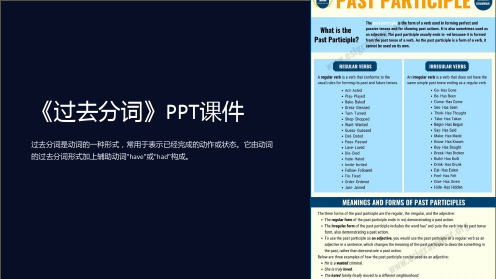
过去分词的常见错误使用
错误
"I have went to the store."
正确
"I have gone to the store."
错误
"The dog has bited me."
正确
"The dog has bitten me."
《过去分词》PPT课件
过去分词是动词的一种形式,常用于表示已经完成的动作或状态。它由动词 的过去分词形式加上辅助动词"have"或"had"构成。
什么是过去分词
形式
动词的过去分词形式由动词原形加上"-ed"(或其他变形)构成。
功能
过去分词可以用作谓语动词、形容词或独立的名词。
举例
例如:"The broken vase"(打破的花瓶,过去分词作形容词)。
作为名词
例如:"My chosen candidate won the election."
过去分词的时态
过去分词的时态由前面的助动词来决定,如"have"表示现在完成时,"had"表示过去完成时。
现在完成时
例如:"I have finished my homework."
过去完成时
例如:"She had already left when I arrived."
1 完成动作
过去分词可以表示已经完 成的动作,如:"He has eat语 态,如:"The book was written by Mark Twain."
过去分词用法总结(共53张PPT)
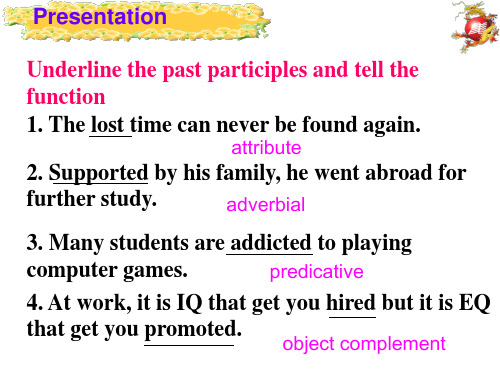
the fallen leaves
boiled water
the risen sun
The broken window made the house very ugly.
The window which was broken made the house very ugly.
过去分词作定语可以转换为一个定语从句 Where shall we put the flowers gathered this morning? Where shall we put the flowers which were gathered this morning?
• One afternoon Mr.Smith left his office and went home. To his surprise, he found his car was gone. He had thought he should call the police at once, but he didn’t wish to trouble them. The next afternoon, he was delighted to see his car again. It was in its usual place. He examined it carefully. What surprised him most was to discover two theatre tickets and a letter left on the seats. It said, “We are very sorry. We took your car without permission because we had something urgent to do. Thanks a lot .” Completely taken in by the note, Mr.Smith was sure that everything was true. He and his wife spent a wonderful evening in the theatre. When they returned home at night, they were astonished to find the house broken in and almost everything taken away from their house.
过去分词的各种用法课件精编版

【注意】过去分词所表示的动作一定和宾 语有逻辑上的动宾关系。
“with +宾语+过去分词”结构
“with +宾语+过去分词”结构中,过去分词用作介词 with的 宾语补足语。这一结构通常在句中作时间、方式、条件、原因 等状语。例如:
(1) The murderer was brought in, with his hands tied behind his back. 凶手被带进来了,他的双手被绑在背后。(表方式) (2) With water heated, we can see the steam. 水一被加热,我们 就会看到水蒸气。(表条件) (3) With the matter settled, we all went home. 事情得到解决, 我们都回家了。(表原因) (4) She stood in front of him, with her eyes fixed on his face. 她 站在他面前,眼睛注视着他。 (5) He stood for an instant with his hand still raised. 他仍然举着 手站了一会儿。
(1) Given another hour, I can also work out this problem.
再给我一个小时,我也能解这道题。( given 为过去分词作状语,它的逻辑主语为 主句主语 I ,即 I 被再给一个小时。)
(2) Seen from the top of the hill, the city looks more beautiful to us.
当我们听到英勇事迹后很受感动。
过去分词作定语
1.
We must adapt ourselves to the changed conditions.
“with +宾语+过去分词”结构
“with +宾语+过去分词”结构中,过去分词用作介词 with的 宾语补足语。这一结构通常在句中作时间、方式、条件、原因 等状语。例如:
(1) The murderer was brought in, with his hands tied behind his back. 凶手被带进来了,他的双手被绑在背后。(表方式) (2) With water heated, we can see the steam. 水一被加热,我们 就会看到水蒸气。(表条件) (3) With the matter settled, we all went home. 事情得到解决, 我们都回家了。(表原因) (4) She stood in front of him, with her eyes fixed on his face. 她 站在他面前,眼睛注视着他。 (5) He stood for an instant with his hand still raised. 他仍然举着 手站了一会儿。
(1) Given another hour, I can also work out this problem.
再给我一个小时,我也能解这道题。( given 为过去分词作状语,它的逻辑主语为 主句主语 I ,即 I 被再给一个小时。)
(2) Seen from the top of the hill, the city looks more beautiful to us.
当我们听到英勇事迹后很受感动。
过去分词作定语
1.
We must adapt ourselves to the changed conditions.
《过去分词》课件

例如,cost -> cost, hurt -> hurt
03
过去分词的用法
作为谓语使用
总结词
表示被动或完成
详细描述
过去分词在谓语中常用于表示被动或完成的状态,如“The book was borrowed by me yesterday. (这本书昨天被我借走了。)”中的“borrowed”表示被动,“The dishes have been washed. (盘子 已经洗完了。)”中的“washed”表示完成。
要点一
总结词
表示时间、条件、原因等
要点二
详细描述
过去分词可以作为状语,表示时间、条件、原因等,如 “Having finished the work, she went home. (完成工 作后,她回家了。)”中的“Having finished”表示时间 ,“If seen from the hill, the city looks more beautiful. (如果从山上俯瞰,这座城市看起来更美。)”中 的“seen”表示条件。
填空题练习
总结词
检验学生的应用能力
详细描述
填空题练习主要检验学生是否能够在具体的 语境中正确运用过去分词。这种题型可以帮 助学生更好地理解过去分词的用法,并提高 他们的语言应用能力。
翻译题练习
总结词
提升学生的语言转换能力
详细描述
翻译题练习主要通过英汉互译的方式,让学 生在实际操作中加深对过去分词的理解和运 用。这种题型可以帮助学生提高语言转换能
过去分词
强调动作的完成和结果,常与时间状 语连用,表示某个动作在某个时间点 之前已经完成。
现在分词
强调动作的进行和过程,常与时间状 语连用,表示某个动作正在进行中。
03
过去分词的用法
作为谓语使用
总结词
表示被动或完成
详细描述
过去分词在谓语中常用于表示被动或完成的状态,如“The book was borrowed by me yesterday. (这本书昨天被我借走了。)”中的“borrowed”表示被动,“The dishes have been washed. (盘子 已经洗完了。)”中的“washed”表示完成。
要点一
总结词
表示时间、条件、原因等
要点二
详细描述
过去分词可以作为状语,表示时间、条件、原因等,如 “Having finished the work, she went home. (完成工 作后,她回家了。)”中的“Having finished”表示时间 ,“If seen from the hill, the city looks more beautiful. (如果从山上俯瞰,这座城市看起来更美。)”中 的“seen”表示条件。
填空题练习
总结词
检验学生的应用能力
详细描述
填空题练习主要检验学生是否能够在具体的 语境中正确运用过去分词。这种题型可以帮 助学生更好地理解过去分词的用法,并提高 他们的语言应用能力。
翻译题练习
总结词
提升学生的语言转换能力
详细描述
翻译题练习主要通过英汉互译的方式,让学 生在实际操作中加深对过去分词的理解和运 用。这种题型可以帮助学生提高语言转换能
过去分词
强调动作的完成和结果,常与时间状 语连用,表示某个动作在某个时间点 之前已经完成。
现在分词
强调动作的进行和过程,常与时间状 语连用,表示某个动作正在进行中。
过去分词变化规则-PPT课件

2.词尾为-ow,-aw时,过去式将其变为-ew,过去分词在 其原形后加n。
blow—blew—blown draw—drew—drawn grow— grew—grown know—knew—known throw—threw—thrown (show除外)
3.词尾为“i+辅(1个)+e”,过去式将i变为o,过去 分词多在原形后加n,若那个辅音字母为d或t,须双写d或 t后加n。(give,hide除外)
过去分词的用法
表示动作的完成 或者被动
一.AAA型(动词原形、过去式、过去分词同形)
cost(花费)cost--cost cut(割)--cut--cut hit(打)--hit-- hit hurt 伤害)--hurt-- hurt let(让)--let --let put(放)--put --put read (读)--read-- read
11.改变元、辅音字母。
leave—left—left stand—stood—stood have(has)— had—had understand—understood—understood
五.ABC型(动词原形、过去式与过去分词三者不同形)
1.i—a—u变化。
begin—began—begun drink—drank—drunk sing— sang—sung ring—rang—rung swim—swam—swum sink— sank—sunk
2.词尾有-ild,-end时,只需把d变为t。
build—built—built lend—lent— lent send—sent—sent spend—spent— spent
3.过去式、过去分词都含有 -aught。
过去分词PPT课件

Ⅰ. Finish the following exercises.
1. If I had the chance, I would have a c_l_o_n_e_d_ (clone) baby.
A.clone C. cloning
B. to clone D. cloned
If I had the chance, I would have a baby w__h_o_i_s_c_l_o_n_e_d_.
规律(1):
单个的及物动词-ed形式作定语往往置于被修饰词_前___
(前/后),表示__被__动__或__完__成___(主动/进行/被动/完成)
意义,可改写成动词用__被__动____(主动/被动)形式的
_定__语__从__句___。
2021
18
* 过去分词短语作定语,置于被修饰词的后面 ,同样可改成定语从句。
finish-finished know-known complete-completed fall-fallen imagine-imagined forget-forgotten
规则动词的过去分词直接在动词词尾加
上-ed或 -d , 不规则动词的过去分词有不 规则的变化,需要单独记忆。
2021
3
work in the USA, a
developed country.
Now he lives in the
countryside. He is
taking a walk on the
path(小路) which is
covered with fallen
leaves.
2021
24
1. What does fallen leaves mean?
过去分词课件PPT课件
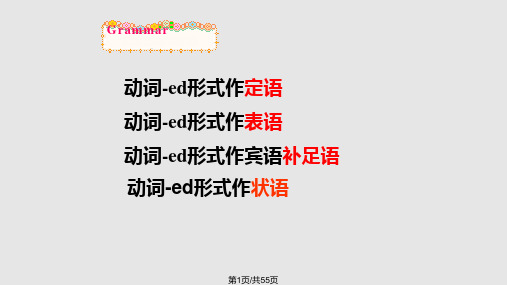
Grammar
动词-ed形式作定语 动词-ed形式作表语 动词-ed形式作宾语补足语 动词-ed形式作状语
第1页/共55页
一、动词-ed形式作定语
过去分词作定语往往与被修饰的词靠得很 紧, 渐渐地成为一个复合词。这种分词叫分词
形容词 (the Participle Adjective), 实际上相当
动词的-ed形式可以在“主语+谓语+宾 语+宾语补足语”句型中充当宾语补足语。 在这一结构中, 动词-ed形式和它前面的宾 语构成逻辑上的被动关系。如果这种句子 改为被动语态,原来的宾语补足语变成了主 语补足语。
第17页/共55页
People found the girl beaten black and blue. 人们发现这个女孩被打得青一块紫一块。 (宾语补足语) The girl was found beaten black and blue. (主语补足语)
He grew much tired of the work.
他十分厌倦这工作。
He seemed quite delighted at the idea.
听了这想法他似乎很高兴。 第12页/共55页
高考题
1) Cleaning women in big cities usually get
____ by the hour. (NMET98)
I have never heard him spoken ill of others.
我从未听过有人说他的坏话。
She felt a great weight taken off her mind.
她觉得心里轻松了些。
They considered the matter settled.
动词-ed形式作定语 动词-ed形式作表语 动词-ed形式作宾语补足语 动词-ed形式作状语
第1页/共55页
一、动词-ed形式作定语
过去分词作定语往往与被修饰的词靠得很 紧, 渐渐地成为一个复合词。这种分词叫分词
形容词 (the Participle Adjective), 实际上相当
动词的-ed形式可以在“主语+谓语+宾 语+宾语补足语”句型中充当宾语补足语。 在这一结构中, 动词-ed形式和它前面的宾 语构成逻辑上的被动关系。如果这种句子 改为被动语态,原来的宾语补足语变成了主 语补足语。
第17页/共55页
People found the girl beaten black and blue. 人们发现这个女孩被打得青一块紫一块。 (宾语补足语) The girl was found beaten black and blue. (主语补足语)
He grew much tired of the work.
他十分厌倦这工作。
He seemed quite delighted at the idea.
听了这想法他似乎很高兴。 第12页/共55页
高考题
1) Cleaning women in big cities usually get
____ by the hour. (NMET98)
I have never heard him spoken ill of others.
我从未听过有人说他的坏话。
She felt a great weight taken off her mind.
她觉得心里轻松了些。
They considered the matter settled.
高中英语过去分词的用法课件(共53张PPT)

– Can those ____ at the
back of the classroom
hear me?
A. seat
B. sit
C. seated D. sat
35、___ in the queue for half an hour, the man suddenly realized he had left the money in the car. A. Waiting B. To wait C. Having Waited D. To have waited
非谓语动词的用法讲解:
过去分词的用法
过去分词作定语
作定语用的过去分词相当于形容词,表被动或表完成
1. 过去分词用作定语,如果是单个词语,常置于其所修 饰的名词之前。
The injured workers are now being taken care of in the hospital.
2.过去分词用作定语,如果是短语,一般置于其所修饰的 名词之后,其意义相当于一个定语从句。
The two theories were interesting. The news were disappointing. The result of the exam is delighting. What he does is satisfying.
• They were __s_u_rp__ri_s_e_d__ at the news.(惊奇于)
因为写得匆忙,这篇文章不是很好。
值得注意的是,有些过去分词作状语时不表 被动而表主动。这样的过去分词及短语常见 的有:
lost ( 迷 路 ) ; seated ( 坐 ) ; hidden ( 躲 ) ; stationed ( 驻 扎 ) ; lost / absorbed in ( 沉 溺 于 ) ; born (出身于); dressed in (穿着); tired of (厌烦)。
《过去分词的用法》PPT课件
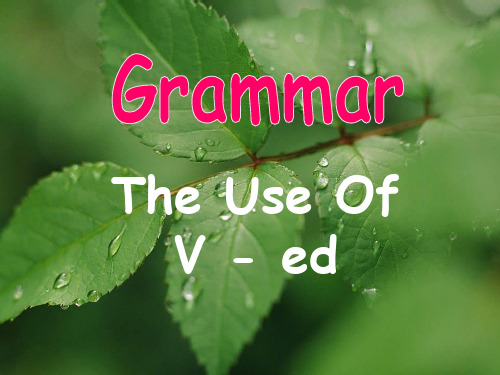
--精品--
1. Past Participle used as attribute
The ground is covered by __fa__ll_e_n___
(fall) leaves.
--精品--
These __w__a_n_t_e_d__ (want) people
are from Hong Kong.
--精品--
Translation
1. 我有些话要说。 I have some words to say. 2. 昨天我理了发。 I had my hair cut yesterday.
--精品--
3. 我叫弟弟寄了一封信。 I had my brother post a letter.
4. 别让机器一直开着。 Don’t have the machine running.
The excited person--i精s品-R- onaldo.
作定语
单词分词+被修饰的词 被修饰的词+分词短语
1、现在分词作定语,当分词单独做定语时,放在所修饰 的名词前;如果是分词短语做定语放在名词后。
They found a damaged car at the gate of the park.
--精品--
2. Past Participle used as predicative
The shop is __c_l_o_s_e_d__(close).
--精品--
Cleaning women in big cities usually
get __p_a_i_d_ (pay) by the hour.
A. smoke B. smoking C. to smoke D.smoked
1. Past Participle used as attribute
The ground is covered by __fa__ll_e_n___
(fall) leaves.
--精品--
These __w__a_n_t_e_d__ (want) people
are from Hong Kong.
--精品--
Translation
1. 我有些话要说。 I have some words to say. 2. 昨天我理了发。 I had my hair cut yesterday.
--精品--
3. 我叫弟弟寄了一封信。 I had my brother post a letter.
4. 别让机器一直开着。 Don’t have the machine running.
The excited person--i精s品-R- onaldo.
作定语
单词分词+被修饰的词 被修饰的词+分词短语
1、现在分词作定语,当分词单独做定语时,放在所修饰 的名词前;如果是分词短语做定语放在名词后。
They found a damaged car at the gate of the park.
--精品--
2. Past Participle used as predicative
The shop is __c_l_o_s_e_d__(close).
--精品--
Cleaning women in big cities usually
get __p_a_i_d_ (pay) by the hour.
A. smoke B. smoking C. to smoke D.smoked
高中英语语法 过去分词的用法(21张PPT)

the risen sun a lost child
已经升起的太阳 丢失的孩子
过去分词短语作定语时,位于它所 修饰的名词或代词后面。
people addicted to drugs a novel written by Luxun
the advice given to the patient
an old man supported by his son a school built for orphans
落叶
the risen sun 升起来的太阳
the advanced countries 发达国家
a drunken man 一个醉鬼
a returned student 一名留学生
a retired teacher 一名退休教师
an escaped prisoner 一名逃跑的囚犯
by-gone days
• The tiger looks _fr_i_g_h_te_n_in(gfrighten), but LiPing wasn’t __fr_ig_h_t_e_n_ed (frighten).
Cleaning women in big cities usually get ____ by the hour.
2. Exciting story
感到失望的人们
Excited people 2. 激动人心的故事
(感到)激动的人们
3.
Tired tired
people/
I’m
3. 累了的人/我感到累了 (使人觉得)无聊的电影
4. Tiring film
V-ed
感到…的
is interesting. I'm interested in English.
过去分词用法-PPT课件

•9
定语
3. 被修饰词是由 不定代词 Every/ some/ any/no + thing/ body 所构成的,V-ed后置。 例:有人受伤吗? Is anybody injured?
•10
定语
4. V-ed 短语做(后置)定语,相当于定语从句 He is reading a novel written by Lu Xun. He is reading a novel (which was) written by Lu Xun.
•23
宾语补足语
• 3. 表“希望”、“要求”、“命令” 等 • 如 like, want, wish, order……
例:我可不想我的女儿天黑以后被带出去 I don’t want my daughter to be taken out after dark.
* Want to do sth. Want sb./ sth. done (被动)
•24
宾语补足语
• (to) V./ V-ing/ V-ed 作宾补的区别 I saw him take away the book just now. 主动(结果) I saw him taking away the book on the desk正. 在(过程) I saw the book taken away by a child. 被动
* See sb./ sth. done
•21
宾语补足语
2. 表“使让” 使役动词(let, make, get, keep, leave, have) + V-ed, 表使让。
It was so cold that the driver couldn’t get the car started.
定语
3. 被修饰词是由 不定代词 Every/ some/ any/no + thing/ body 所构成的,V-ed后置。 例:有人受伤吗? Is anybody injured?
•10
定语
4. V-ed 短语做(后置)定语,相当于定语从句 He is reading a novel written by Lu Xun. He is reading a novel (which was) written by Lu Xun.
•23
宾语补足语
• 3. 表“希望”、“要求”、“命令” 等 • 如 like, want, wish, order……
例:我可不想我的女儿天黑以后被带出去 I don’t want my daughter to be taken out after dark.
* Want to do sth. Want sb./ sth. done (被动)
•24
宾语补足语
• (to) V./ V-ing/ V-ed 作宾补的区别 I saw him take away the book just now. 主动(结果) I saw him taking away the book on the desk正. 在(过程) I saw the book taken away by a child. 被动
* See sb./ sth. done
•21
宾语补足语
2. 表“使让” 使役动词(let, make, get, keep, leave, have) + V-ed, 表使让。
It was so cold that the driver couldn’t get the car started.
过去分词的用法全面(共46张PPT)

eg: There was nobody invited here. I want to find somebody interested in the
case.
2. v-ed作定语与定语从句的互换: (1) 若是vt.的过去分词作定语表示已经完成的 动作,且含有被动意义,可改成v.用被动形 式的定语从句。
eg: surprisng; moved/ moving...
二、作定语 (attribute)
1. 前置定语:单个的v-ed作定语,一般放在 被修饰的n.之前; 后置定语:v-ed短语作定语时,常被放在被 修饰的n.之后,相当于一个定语从句。 eg: an invited guest 一位受到邀请的客人
过去分词所充当的成分:
一、作表语 (predicative)
1. 过去分词作表语,表示主语的心理感觉或 所处的状态,其用法相当于adj.,放在系动 词后面。 eg: The door remained locked till 7 o’clock.
eg: I am pleased with the result of the
eg: The injured bird lay on the ground.
eg: a letter written in blue ink
eg: The boy named Tom is my brother.
注意:
如果被修饰的词是复合不定代词或指示代词 those等时,即使是一个单一的分词作定语也 要放在被修饰的词之后。
eg: The letter posted today will reach you in a week. =
The letter which was posted today will...
case.
2. v-ed作定语与定语从句的互换: (1) 若是vt.的过去分词作定语表示已经完成的 动作,且含有被动意义,可改成v.用被动形 式的定语从句。
eg: surprisng; moved/ moving...
二、作定语 (attribute)
1. 前置定语:单个的v-ed作定语,一般放在 被修饰的n.之前; 后置定语:v-ed短语作定语时,常被放在被 修饰的n.之后,相当于一个定语从句。 eg: an invited guest 一位受到邀请的客人
过去分词所充当的成分:
一、作表语 (predicative)
1. 过去分词作表语,表示主语的心理感觉或 所处的状态,其用法相当于adj.,放在系动 词后面。 eg: The door remained locked till 7 o’clock.
eg: I am pleased with the result of the
eg: The injured bird lay on the ground.
eg: a letter written in blue ink
eg: The boy named Tom is my brother.
注意:
如果被修饰的词是复合不定代词或指示代词 those等时,即使是一个单一的分词作定语也 要放在被修饰的词之后。
eg: The letter posted today will reach you in a week. =
The letter which was posted today will...
过去分词用法详解ppt课件
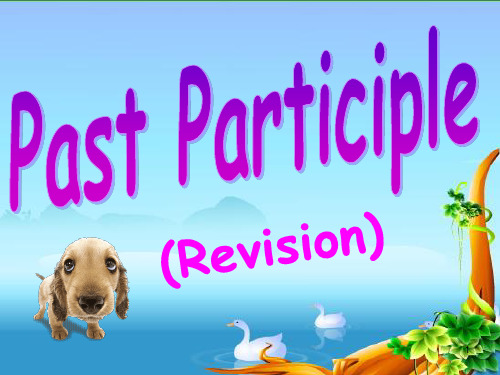
A. recorded
B. record
D. having recorded
4.Linda worked for the Minnesota Manufacturing and Mining
company, _B__as 3M.(04’ZJ)
A. knowing B. known C. being known D. to be known
6
﹡ ﹡ The differences (used as Attribute)
5. to do 表示一个将来的动作 to be done 表示一个将来的被动动作 doing 表示一个正在进行的主动动作 being done 表示一个正在进行的被动动作 e.g. I have much work to do. The building to be finished at the end of this year will be our lab
2.介词with+宾语+过去分词
The thief was brought in with his hands tied behind his back. With all the work finished, he went back.
15
Exercises:
1.You should understand the traffic rule by now. You’ve had it
5.----Shall we go swimming ?
----OK. I’ll just go and get __A___.
A. changed B. to change C. to be changed D. changing
13
Step Ⅲ used as Object Complement 1.及物动词的过去分词作宾补表示一个完成且被动的动 作; 不及物动词的过去分词作宾补只表示动作的完成和 状态。
- 1、下载文档前请自行甄别文档内容的完整性,平台不提供额外的编辑、内容补充、找答案等附加服务。
- 2、"仅部分预览"的文档,不可在线预览部分如存在完整性等问题,可反馈申请退款(可完整预览的文档不适用该条件!)。
- 3、如文档侵犯您的权益,请联系客服反馈,我们会尽快为您处理(人工客服工作时间:9:00-18:30)。
3. 过去分词作状语来源于状语从句。 (1) Caught in a heavy rain, he was all wet. 因 为淋了一场大雨,所以他全身湿透了。 (caught in a heavy rain 为过去分词短语作原因状语,它来源 于原因状语从句 Because he was caught in a heavy rain.) (2) Grown in rich soil, these seeds can grow fast. 如果种在肥沃的土壤里,这些种子能长得很快 。( grown in rich soil 为过去分词作条件状语,它 来源于条件状语从句 If these seeds are grown in rich soil.
• 2.表愿望,想法的动词want ,should • like ,would like等 • I want my eggs fried. • 我想要煎鸡蛋。 • I’d like LiLei invited too. • 我也想邀请李雷。
3. 表示“致使”意义的动词。如:have, make, get, keep, leave ,make等。 (1) I’ll have my hair cut tomorrow. 明天 我要理发。 (2) He got his tooth pulled out yesterday. 他昨天把牙拔了。 (3) Don’t leave those things undone. 要 把那些事情做完。 【注意】过去分词所表示的动作一定和宾 语有逻辑上的动宾关系。
“with +宾语+过去分词”结构
“with +宾语+过去分词”结构中,过去分词用作介词 with的 宾语补足语。这一结构通常在句中作时间、方式、条件、原因 等状语。例如: (1) The murderer was brought in, with his hands tied behind his back. 凶手被带进来了,他的双手被绑在背后。(表方式) (2) With water heated, we can see the steam. 水一被加热,我们 就会看到水蒸气。(表条件) (3) With the matter settled, we all went home. 事情得到解决, 我们都回家了。(表原因) (4) She stood in front of him, with her eyes fixed on his face. 她 站在他面前,眼睛注视着他。 (5) He stood for an instant with his hand still raised. 他仍然举着 手站了一会儿。
过去分词作定语
作定语用的过去分词相当于形容词,其逻辑主 语就是它所修饰的名词。及物动词的过去分词 作定语,既表被动又表完成;不及物动词的过 去分词作定语,只表完成。 1. 过去分词用作定语,如果是单个的,常置于其 所修饰的名词之前。
We must adapt our thinking to the changed conditions. 我们必须使我们的思想适应改变了的情况 。
ቤተ መጻሕፍቲ ባይዱ
1.你认识那个穿着红衣服的妇女吗? 2.舒服地坐在椅子上,他在沉思。 3.给予更多的关心的话,这些树会长得更好。 4.他作了自我介绍,以便使自己被大家认识。 5.昨天,我把衣服让人洗了。 6.上周一,我看到你兄弟被一个陌生人打了。 7.将书合上背诵这篇课文。 8.我提高了声音以便使自己被听见。 9.如果被问及,你不要说我在家里。
mountains. 这座城市三面环山。
【注意】过去分词作表语与被动语态的区别:过去分 词作表语,主要是表示主语的状态,而被动语态则 表示动作。
(1) The cup was broken by my little sister yesterday. 茶杯是昨天我小妹打碎的。(是被动语态,表示动作) (2) The library is now closed. 图书馆关门了。(过去分 词作表语)
非谓语动词的用法讲解:
过去分词的用法
过去分词用法有:
• • • • 做表语 做定语 做宾语补足语 做状语
过去分词作表语
1. 及物动词的过去分词作表语,与句子主语是 被动关系,表示主语的状态,既表示被动, 又表示完成。
(1) The cup is broken. 茶杯破了。
2. 不及物动词的过去分词作表语,与句子主语 是主动关系,表示主语的状态,只表示动作 的完成。 (2) He is retired. 他已退休。 3. 有些过去分词作表语时,构成的谓语很接近 被动结构。 (3) The city is surrounded on three sides by
【注意】如果过去分词作状语时,前面再加逻 辑主语,主句的主语就不再是分词的逻辑主语 ,这种带逻辑主语的过去分词结构实际上属于 独立主格结构。 (1) The signal given, the bus started. 信 号一发出,汽车就开动了。(the signal 是 given 的逻辑主语,因此主句主语 the bus 就 不是given 的逻辑主语。 (2) Her head held high, she went by. 她把 头昂得高高地从这儿走了过去。(her head 是 held high 的逻辑主语,因此主句主语 she 就不再是held high 的逻辑主语。)
【注意】过去分词表示被动或完成, -ing 形式表示主 动或进行。有些动词如 interest, bore, worry, surprise, frighten 等通常用其过去分词形式来修 饰人,用 -ing 形式来修饰物。
(3) The book is interesting and I'm interested in it. 这 本书很有趣,我对它很感兴趣。
过去分词作宾语补足语
(一)能够接过去分词作宾补的动词有以下三 类: 1. 表 示 感 觉 或 心 理 状 态 的 动 词 。 如 : see, watch, observe, look at, hear, listen to, feel, notice, think等。 (1) I heard the song sung in English. 我听到有人用英语唱过这首歌。(过去分词 sung的动作显然先于谓语动作heard;) (2) He found his hometown greatly changed. 他发现他的家乡变化很大。(过去 分 词 changed 的 动 作 显 然 先 于 谓 语 动 作 found)
过去分词作状语 1. 过去分词作状语过去分词作状语表示被动的和完成的 动作。 (1) Written in a hurry, this article was not so good! 因为写得匆忙,这篇文章不是很好。 【注意】written 为过去分词作状语,表示这篇文章是 被写的,而且已经被写。 值得注意的是,有些过去分 词因来源于系表结构,作状语时不表被动而表主动。 这样的过去分词及短语常见的有: lost (迷路); seated (坐); hidden (躲); stationed (驻扎 ); lost / absorbed in (沉溺于); born (出身 于); dressed in (穿着); tired of (厌烦) ;addicted to;devoted to。 (2) Lost / Absorbed in deep thought, he didn’t hear the sound.因为沉溺于思考之中,所以他没听到 那个声音。
2. 过去分词短语用作定语时,一般置于其所修饰 的名词之后,其意义相当于一个定语从句,但 较从句简洁,多用于书面语中。
The concert given by their friends was a success.他 们朋友举行的音乐会大为成功。
3.过去分词短语有时也可用作非限制性定语,前 后常有逗号。 (1)The meeting, attended by over five thousand people, welcomed the great hero. 他们举行了欢迎英雄的大会,到会的有 五千多人。 4. 用来修饰人的过去分词有时可以转移到修饰非 人的事物,这种过去分词在形式上虽不直接修 饰人,但它所修饰的事物仍与人直接有关。如 与人有关的词look,face,expression等。 (2) The boy looked up with a pleased expression. 男孩带着满意的表情举目而视。
【注意】状语从句改成过去分词作状语时有时 还可保留连词,构成“连词+过去分词”结构 作状语。 When given a medical examination, you should keep calm. 当你做体格检查时要保 持镇定。 4. 过去分词作状语的位置。过去分词可放在主句 前作句首状语,后面有逗号与主句隔开;也可 放在主句后面,前面有逗号与主句隔开。 He stood there silently, moved to tears. = Moved to tears, he stood there silently. 他静静地站在那里,被感动得热泪盈眶。
10.你参加了昨天举行的会议吗? 11.我想把这封信寄出去。 12.我们没有足够的食物吃的日子一去部 复返了。 13.我们必须适应改变了的形式。 14.他们在看足球比赛,兴奋而又满意。 15.他说爬山很累。但是我一点也不累。 16.即使在森林里迷路了,他也不担心。
• 3.他只想用建筑材料。 • He only wanted natural materials to be used. • 4.Frank Lloyd Wright 发现自己的灵感来自 • 于日本的海贝壳。 • Frank Lloyd Wright found himself inspired • by Japanese seashells. • 5.我听到我们学校里有人唱歌。 • I heard the song sung in our school.
